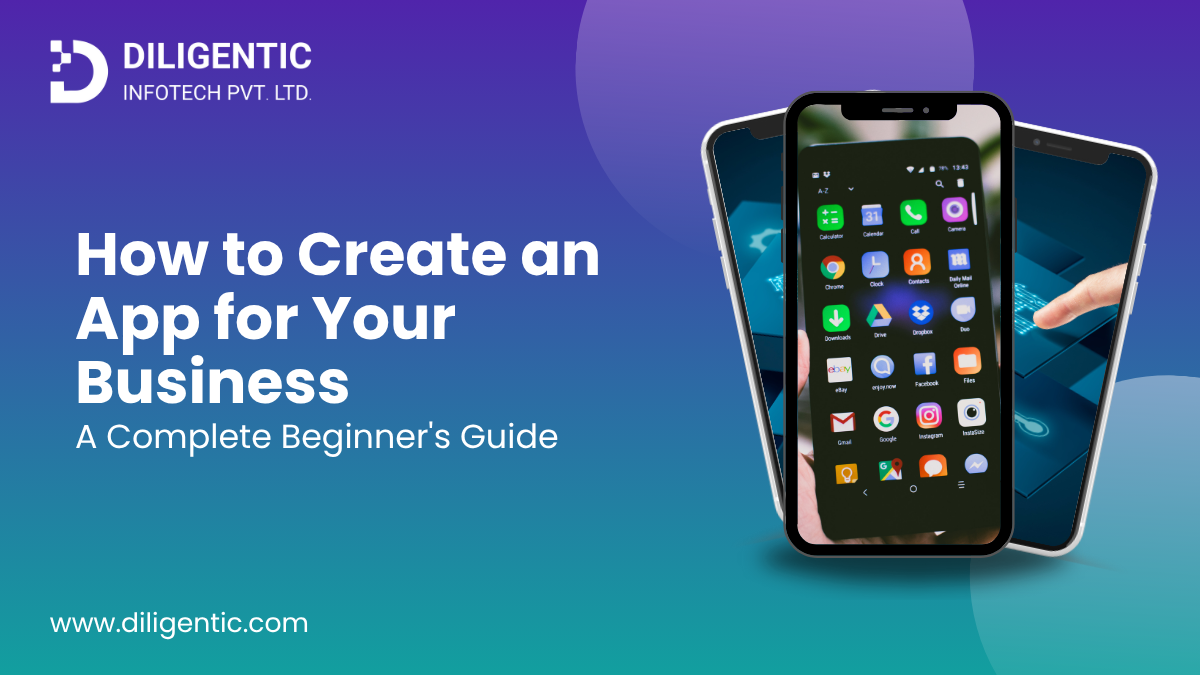SHARE

How to Create an App for Your Business – A Complete Beginner’s Guide

Creating an app for your business isn’t just for tech companies anymore. Whether you run a retail store, clinic, gym, or logistics firm, an app can directly improve customer experience, streamline your operations, and increase revenue. This guide will walk you through how to create an app step-by-step, explain mobile app development cost, and help you decide what’s best for your business goals.
Table of Contents
Why You Should Consider Building a Business App
People spend most of their screen time on mobile apps. That’s where your customers are, and that’s where your business should be too.
A mobile app allows you to:
- Offer seamless booking and ordering experiences
- Send personalized notifications
- Simplify communication
- Collect useful customer data
- Build long-term loyalty
The demand for mobile-first interactions continues to rise. If you’re still relying on calls, emails, or just a website, you’re missing a significant engagement opportunity. Businesses that understand how to build an app are staying ahead by meeting users where they spend the most time, on their phones.
Start With a Clear Goal
Don’t rush into development. Start by understanding exactly what you want your app to do. Ask yourself:
- What core problem will this app solve?
- What action do I want users to take most often?
- How will it benefit my business in the long run?
Let’s say you run a fitness studio. Your app could allow users to:
- View class schedules
- Book and cancel slots
- Get notifications about new classes
- Pay securely within the app
By being laser-focused on your goal, you avoid overcomplicating the app and keep costs under control.
Decide Which Type of App You Need

Not all apps are built the same. Depending on your goals, budget, and timeline, you can choose from different types of apps.
1. Native App
Built specifically for either Android or iOS.
- Pros: Fast performance, better UI/UX
- Cons: Expensive, separate builds for Android and iPhone
2. Hybrid App
It uses the same code for both Android and iPhone
- Pros: Cost-effective, quicker development
- Cons: Slightly lower performance than native apps
3. Progressive Web App (PWA)
Works in a web browser but behaves like a mobile app.
- Pros: No need to download, easy to maintain
- Cons: Limited access to device features like camera or GPS
4. No-Code App Builders
Platforms like Glide or Adalo allow drag-and-drop app building.
- Pros: No coding required, fast to launch
- Cons: Limited customization and scalability
If your app is simple and you’re testing the idea, starting with a no-code tool or hybrid approach is a smart move.
Should You Make an Android App or iPhone App First?
It depends on your audience. If most of your customers use Android (common in Asia, Africa, and Latin America), build that first. If your market is iPhone-heavy (like the USA or Europe), iOS should be your priority.
If you want both, hybrid development with frameworks like React Native or Flutter lets you build for Android and iPhone at the same time, saving cost and time.
Create a Feature List
When thinking about how to make an app, remember—it shouldn’t try to do everything at once. Focus on the core problem you’re solving and build from there. Stick to the essentials first.
- User registration/login
- Home screen or dashboard
- Search or filters
- Product or service listing
- Payment integration
- Order history
- Push notifications
- Contact or help section
These features cover most business needs. Add advanced features only after you validate your app idea with real users.
Design the User Experience (UX)

Design isn’t just about looking good. It’s about making your app easy to use.
Here are some key tips:
- Use clear icons and large buttons
- Keep navigation simple (2–3 levels max)
- Stick to one color palette
- Test your design on different screen sizes
- Avoid too much text on mobile screens
You can use free tools like Figma to sketch your app or hire a UI/UX designer to create mockups.
Understand the Mobile App Development Cost

One of the most common questions is: How much does it cost to make an app?
Here’s a general breakdown:
| App Type | Cost Range |
|---|---|
| No-Code App | $2,000 – $10,000 |
| Basic Hybrid App (MVP) | $8,000 – $20,000 |
| Mid-Level Custom App | $20,000 – $50,000 |
| Full-Featured App | $50,000 – $150,000+ |
The mobile app development cost varies based on:
- App complexity
- Platform (Android, iPhone, or both)
- Design and animations
- Backend setup and APIs
- Developer expertise
Tip: Start with a basic version (called an MVP) and upgrade based on user feedback.
Find the Right Development Team
You have two options:
Option 1: Use a No-Code Platform
Tools like Thunkable, Glide, and Adalo allow you to build apps without code. Great for prototyping or internal tools.
Option 2: Hire a Mobile App Development Company
A professional team will:
- Understand your business logic
- Write clean, scalable code
- Integrate payment gateways and third-party APIs
- Ensure your app meets App Store and Play Store guidelines
- Provide post-launch support
If you’re serious about scaling, working with a mobile app development company like Diligentic Infotech ensures that your app is built for long-term success.
Development and Testing
Once you finalize features and design, it’s time to build.
Developers will choose the tech stack (React Native, Flutter, etc.), write the code, and connect everything to a backend database.
Next comes testing:
- Check on different devices
- Fix layout issues
- Test login, payments, and notifications
- Ensure no data leaks or crashes
Beta testing with a small group helps catch last-minute bugs before the public launch.
Publish Your App to the Store
Here’s how to make your app available to everyone:
- Create developer accounts
- Android (Google Play Console): $25 one-time
- iPhone (Apple Developer Account): $99/year
- Prepare app store assets
- Icon, screenshots, description, and privacy policy
- Submit and wait
- Google reviews may take up to seven days
- Apple usually approves within one to two days
Once approved, your app will be live and available to download.
Promote Your App and Track Results
Building the app is only half the work. If you’ve learned how to create an app, the next step is getting people to use it.
Promotional ideas:
- Add app links on your website and emails
- Share on Instagram, Facebook, and WhatsApp
- Run paid ads for installs
- Offer referral codes or loyalty rewards
- Use QR codes at your physical store
Use tools like Firebase Analytics or Mixpanel to monitor app usage, track engagement, and make improvements.
Conclusion
If you’ve been wondering how to create an app, the process doesn’t have to be overwhelming. Start with a clear goal, pick the right tech stack or platform, and focus on what your users need most. Your app doesn’t need to be perfect on day one. It needs to be useful.
Want expert help turning your idea into a real app?
👉 Let’s talk with the team at Diligentic Infotech. We’ll help you plan, design, build, and launch your app, without the confusion.
FAQs
How much does it cost to create an app for a business?
It can range from $2,000 for basic no-code apps to $50,000+ for full-featured native apps, depending on complexity.
Can I make an app without coding?
Yes, tools like Glide, Adalo, and Thunkable let you create apps without writing a single line of code.
Is it better to build an Android app or iPhone app first?
Choose Android if your audience is in Asia or Africa; iPhone if it’s in the US or Europe. You can also build for both using hybrid frameworks.
How to make an Android app and iPhone app on a budget?
Use cross-platform tools like React Native or Flutter. They allow one codebase for both platforms, reducing development cost.
How to Build an App that users keep?
Prioritize one core problem, nail the UX, add analytics, and iterate from feedback loops.
Engage with our experts
Subscribe to our newsletter!
Be the first to get exclusive offers and the latest news.
Posted on 28 Aug 2025
The End of MVP Culture? Why Startups Are Choosing Native Again: 2025 Reality Check
It’s 2025. For years, MVP (Minimum Viable Product) was the default for startup launches. Build fast, test in public, and iterate later. But the game has changed. Startups, investors, and users all want more. Is it the end of MVP culture? Let’s break down the reality, reveal why “MVP is dead” trends matter, and unpack why native experiences are winning out in today’s startup scene.
Posted on 15 Sep 2025
Idea to Launch: How to Develop Commercial Real Estate Apps (Complete Guide)
Commercial real estate apps turn complex transactions into straightforward processes, helping property management companies, brokers, and investors work more efficiently, comply with regulations, and adapt to market changes in real time.
Posted on 24 Sep 2025
React Native App Development Cost in 2025: How Much Does It Really Take?
In 2025, developing a React Native app can cost anywhere from around $15,000 for a simple MVP to over $150,000 for large-scale enterprise apps. The final price mainly depends on factors like the app’s complexity, features, design, and where the development team is based.

Reach out
Let’s Start Together
We're a collective of high caliber designers, developers, creators, and geniuses. We thrive off bouncing your ideas and opinions with our experience to create meaningful digital products and outcomes for your business.
Phone Number
+1 (825) 760 1797
hello[at]diligentic[dot]com
